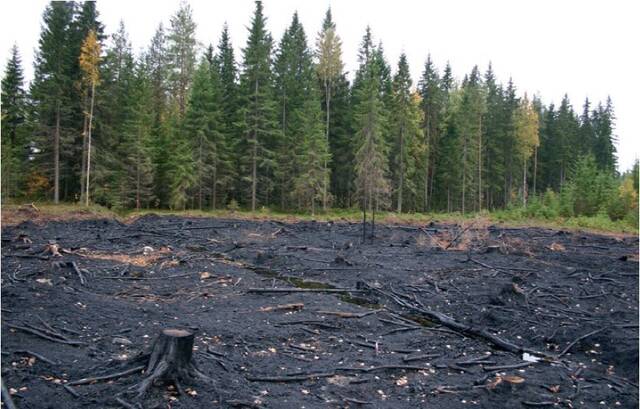Hyggesbränning
Ordlista
- Hyggesbränning
Hyggesbränning innebär att hyggesresterna och markvegetationen bränns, ofta i samband med skogsförnyelse. Hyggesbränning görs för att förbättra skogsodlingsresultatet och öka trädens tillväxt. Metoden kan också användas för att gynna mångfalden och kallas då naturvårdsbränning.
Litteratur
- Lindberg et al., 2020. The challenge of combining variable retention and prescribed burning in Finland. Ecological Processes 9.
https://doi.org/10.1186/s13717-019-0207-3(extern länk) - Kouki J. ym. 2018. Metsät. Julkaisussa: Kontula T., Raunio A. (toim.). Suomen luontotyyppien uhanalaisuus 2018. Luontotyyppien punainen kirja – Osa 1: Tulokset ja arvioinnin perusteet. Suomen ympäristökeskus & ympäristöministeriö, Helsinki. Suomen ympäristö 5/2018. s. 171–201.
http://urn.fi/URN:ISBN:978-952-11-4816-3(extern länk) - Hyvärinen, E., Juslén, A., Kemppainen, E., Uddström, A. & Liukko, U-M. (toim.) 2019: Suomen lajien uhanalaisuus – Punainen kirja 2019. Ympäristöministeriö & Suomen ympäristökeskus.
http://hdl.handle.net/10138/299501(extern länk) - Keto-Tokoi 2018. Tutkimustietoon perustuvia suosituksia vastuullisen metsänhoidon kehittämiseksi. WWF Suomen Raportteja 37.
https://tapio.fi/wp-content/uploads/2021/06/10977.pdf(extern länk) - Koivula, M. & Vanha-Majamaa, I. 2020. Experimental evidence on biodiversity impacts of variable retention forestry, prescribed burning, and deadwood manipulation in Fennoscandia. Ecological Processes 9: 11.
https://doi.org/10.1186/s13717-019-0209-1(extern länk) - Heikkala, O., Martikainen, P. & Kouki, J. 2017. Prescribed burning is an effective and quick method to conserve rare pyrophilous forest-dwelling flat bugs. Insect Conservation and Diversity 10: 32–41.
https://doi.org/10.1111/icad.12195(extern länk) - Toivanen, T. & Kotiaho, J. 2007a. Mimicking natural disturbances of boreal forests: the effects of controlled burning and creating dead wood on beetle diversity. Biodiversity and Conservation 16: 3193–3211.
https://doi.org/10.1007/s10531-007-9172-8(extern länk) - Hjältén ym. 2017. Forest restoration by burning and gap cutting of voluntary set-asides yield distinct immediate effects on saproxylic beetles. Biodiversity and Conservation 26: 1623–1640.
https://doi.org/10.1007/s10531-017-1321-0(extern länk) - Versluijs ym. 2017. Ecological restoration in boreal forest modifies the structure of bird assemblages. Forest Ecology and Management 401: 75–188.
https://doi.org/10.1016/j.foreco.2017.06.055(extern länk) - Toivanen, T. & Kotiaho, J.S. 2007b. Burning of logged sites to protect beetles in managed boreal forests. Conservation Biology 21: 1562–1572.
https://doi.org/10.1111/j.1523-1739.2007.00808.x(extern länk) - Punttila, P. 2020. Metsät. Julkaisussa Pöyry, J. & Aapala, K. (toim.). Lajit ja luontotyypit muuttuvassa ilmastossa. Suomen ympäristökeskuksen raportteja 2/2020: 97–109.
http://hdl.handle.net/10138/311227(extern länk) - Ennallistamistyöryhmä 2003. Ennallistaminen suojelualueilla. Ennallistamistyöryhmän mietintö. Suomen ympäristö 618. Ympäristöministeriö, Helsinki.
http://hdl.handle.net/10138/40488(extern länk) - Kouki ym. 2012. Landscape context affects the success of habitat restoration: large-scale colonization patterns of saproxylic and fire-associated species in boreal forests. Diversity and Distributions 18: 348–355.
https://doi.org/10.1111/j.1472-4642.2011.00839.x(extern länk) - Ranius ym. 2014. Metapopulation dynamics of a beetle species confined to burned forest sites in a managed forest region. Ecography 37: 797–804.
https://doi.org/10.1111/ecog.00475(extern länk) - Matveinen ym. 2015. Metsäelinympäristöt. Julkaisussa Kotiaho, J. S., Kuusela, S., Nieminen, E. & Päivinen, J. (toim.). Elinympäristöjen tilan edistäminen Suomessa. ELITE-työryhmän mietintö elinympäristöjen tilan edistämisen priorisointisuunnitelmaksi ja arvio suunnitelman kokonaiskustannuksista. Suomen ympäristö 8/2015: 100–122.
http://hdl.handle.net/10138/156982(extern länk)
